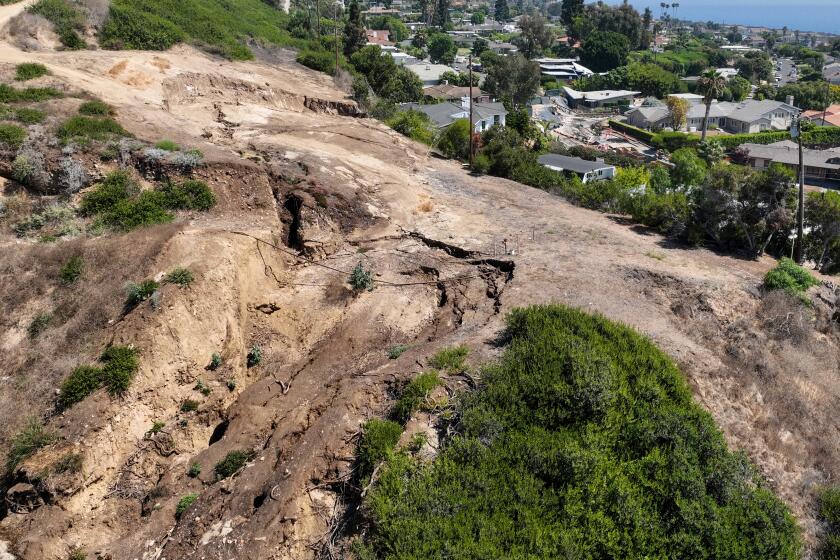Opinion: Why California’s climate solution isn’t cutting it

Many Californians take pride in the state’s position on the front lines of the global climate change struggle, but the dismal performance of its centerpiece climate program — cap and trade — shows that in a crucial way the state’s reputation is undeserved. Even here, in the heartland of climate awareness, it turns out that the oil industry calls the most important shots.
A revelatory November report by ProPublica delineates how the oil industry has successfully gamed the cap-and-trade program. The system is supposed to force a gradual decline in carbon dioxide emissions by issuing polluting companies an annually decreasing number of permits to pollute, but it has granted so many exceptions that the program is nearly toothless.
As a result, since the beginning of cap and trade in 2013, emissions from oil and gas sources — generated by production, refining and vehicle fuel consumption — have increased by 3.5%, according to ProPublica’s analysis. This is alarming, not least because the last of those categories, the transportation sector, is the leading source of emissions in the state.
In fact, the oil industry has found California’s cap-and-trade program so accommodating that it has been promoting similar market-based climate approaches — cap and trade and carbon taxes — around the world, according to ProPublica. The bigger threat to the oil industry is direct regulation, which it consistently opposes. Unlike cap and trade, regulations could target specific economic sectors and focus directly on limiting the oil industry’s carbon pollution.
Market-based policies now dominate programs that are intended to curb climate change. The 2015 Paris climate agreement touted such approaches as a principal method to reduce emissions, and according to a World Bank report in June, at least 57 jurisdictions have established carbon pricing programs. The problem, as the report points out, is that “prices remain too low to deliver on the objectives.”
The oil industry’s leverage over California’s cap-and-trade program stems in part from its successful backing of Proposition 26, a 2010 state ballot initiative that requires a two-thirds majority in the legislature to raise fees, including the cap-and-trade program’s charges for permits to pollute. That meant that in 2017, when state leaders set about extending the program for another decade after 2020, they needed buy-in from legislators in both parties who represent districts with major oil installations. That gave the oil industry an opening to nix provisions it didn’t like.
The compromise that emerged extended cap and trade, but it blocked local air districts from regulating emissions from oil refineries, and it precluded the California Air Resources Board from placing more statewide regulations on oil and gas emissions. CARB then designated the cap-and-trade program as the state’s primary mechanism for regulating emissions, even though it was originally envisioned as a complement to direct regulations.
Meanwhile, the program has issued so many permits to pollute — sold or given to companies in the early days of cap-and-trade, when the cap wasn’t set low enough — that emission levels haven’t dropped significantly enough. In addition, companies have stockpiled enough permits to ward off increased emissions reductions, possibly through the next decade.
The state program also allows for highly dubious offsets, which give companies the right to pollute in return for financing emission-reducing actions elsewhere, such as by protecting a forest or cleaning up a coal mine. But it’s nearly impossible to calculate how much pollution a given offset action prevents, and if, say, the protection of one forest merely causes the logging of another, nothing is gained. Four-fifths of the cap-and-trade program’s offsets involve forest protection, yet Barbara Haya, leader of the UC Berkeley Carbon Trading Project, has found that only a fifth of emissions reductions claimed through forest protection were justified.
Worse, Haya found many instances in which offsets create perverse incentives, generating emissions instead of reducing them. For example, when a highly polluting coal mine captures methane instead of releasing it into the atmosphere, it can sell credits in the offset program. The revenues may allow a financially tottering mine to forestall bankruptcy.
Because of the glut of permits and offsets, the market’s carbon price — currently at $17 a ton — is too low. The World Bank report called for carbon prices of $40 to $80 a ton by 2020 and $50 to $100 a ton by 2030, if we were to reach the Paris agreement goals.
California famously met its 2020 emissions reduction goals four years ahead of schedule, but cap and trade was a negligible factor; almost all the gains occurred in the electricity sector, which cut its reliance on out-of-state coal plants. But the state isn’t on track to meet future goals. A study published in October by Next 10, a San Francisco nonprofit, found that if the rate of emissions reductions that California achieved from 2016 to 2017 holds steady, the state won’t reach its 2030 goal (reducing emissions 40% beneath 1990 levels) until 2061, and it won’t reach its 2050 goal (cutting emissions to 80% beneath 1990 levels) until 2157.
In the face of repeated requests by experts and journalists to show how it will deliver on the state’s 2030 climate law, CARB hasn’t provided a convincing road map or even acknowledged that a problem exists, according to Danny Cullenward, an energy economist and policy director of the climate policy think tank Near Zero. Meanwhile, the Western States Petroleum Assn., the oil industry trade group, has called on CARB to maintain its current course, as it stated in comments to the board on program amendments in 2018.
Because emissions reductions achieved now have far greater climate impact than reductions five or 10 years from now, what’s at stake is urgent. If officials don’t get serious about reducing emissions, the state’s heartening environmental saga could turn out to be a cautionary tale.
Jacques Leslie is a contributing writer to Opinion.
More to Read
A cure for the common opinion
Get thought-provoking perspectives with our weekly newsletter.
You may occasionally receive promotional content from the Los Angeles Times.










